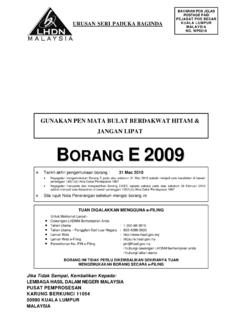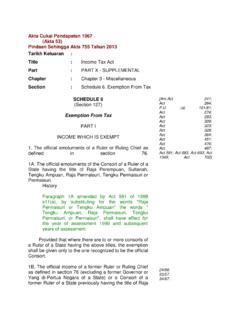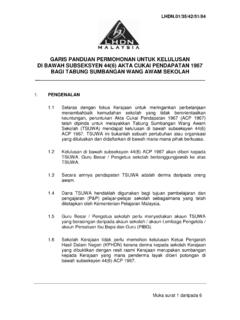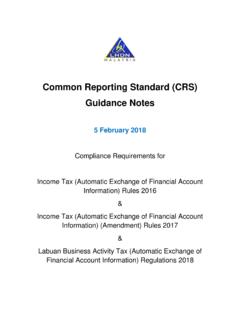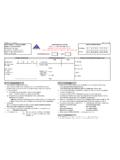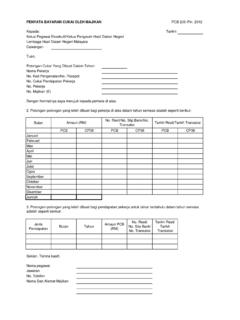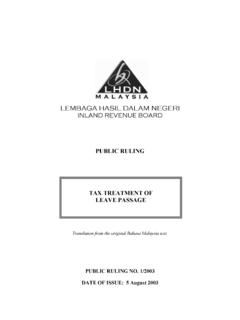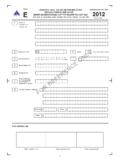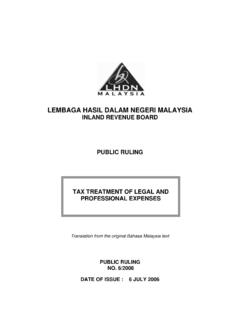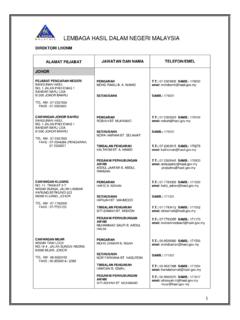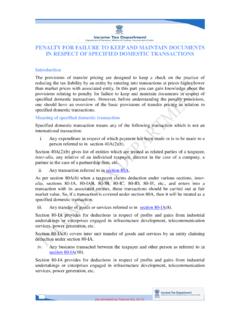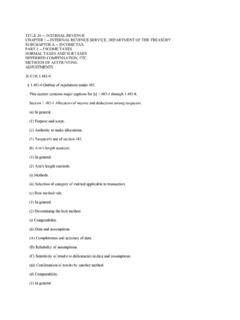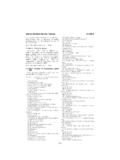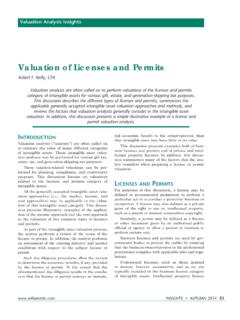Transcription of INLAND REVENUE BOARD MALAYSIA - Hasil
1 INLAND REVENUE BOARD MALAYSIA TRANSFER PRICING GUIDELINES CONTENTS 1. 2. 3. SCOPE OF ..3 4. THE ARM S LENGTH 5. THE CONCEPT OF 5 6. FACTORS DETERMINING ..6 7. ARM S LENGTH PRICING 8. SPECIAL CONSIDERATIONS FOR INTANGIBLE 9. SPECIAL CONSIDERATIONS FOR INTRA-GROUP 10. 1 TRANSFER PRICING GUIDELINES 1. INTRODUCTION Transfer pricing generally relates to the system of pricing the cross-border transfer of goods, services and intangibles between entities in a group of Multinational Enterprise (MNE). Transfer pricing also applies if such transactions were to take place between associated companies within the country.
2 Ideally, the transfer price should not differ from the prevailing market price. However, when business dealings are made between such connected persons, they may not always reflect the dynamics of market forces as would be expected if such transactions were carried out by independent enterprises. As with any tax administration, it is the duty of the INLAND REVENUE BOARD of MALAYSIA (IRB) to ensure that the transfer pricing methodologies adopted by MNEs are reasonable, and that their Malaysian subsidiaries are paying their fair share of tax. In order to do so, MNEs involved must be able to provide adequate documented proof to support their transfer pricing policies. 2.
3 OBJECTIVE The IRB Transfer Pricing Guidelines (hereinafter referred to as the Guidelines) seek to provide all MNEs concerned with information on existing domestic legislation; methodologies acceptable to IRB that can be used in determining arm s length price and administrative regulations including the types of records and documentation expected from taxpayers involved in transfer pricing arrangements. It is the prerogative of the taxpayer to choose from the various methodologies laid out with the ultimate aim of arriving at an arm's length transfer price. It is intended that these guidelines, which may be reviewed from time to time, will assist MNEs in their efforts to determine transfer prices which are consistent with the arm's length principle and at the same time comply with Malaysian tax laws as well as administrative requirements of the IRB.
4 2 IRB MALAYSIA - TRANSFER PRICING GUIDELINES 3. SCOPE OF GUIDELINES The Guidelines are applicable on transactions between associated enterprises within a multinational where one enterprise is subjected to tax in MALAYSIA and the other enterprise is located overseas. The Guidelines are also applicable by analogy, in relation to transactions between a permanent establishment (PE) and its head office or other related branches; where for the purpose of the Guidelines the PE will be treated as a (hypothetically) distinct and separate enterprise from its head office or other related branches. The type of transactions subject to adjustments will include the sale or purchase of inventory; the sale, purchase or lease of tangible assets; the provision of services; the transfer, purchase or use of intangible assets; the lending or borrowing of money; and other transactions which affect the profit or loss of the enterprise involved.
5 The Guidelines are largely based on the governing standard for transfer pricing which is the arm s length principle as set out under the Organisation for Economic Co-operation and Development (OECD) Transfer Pricing Guidelines. Henceforth, all methodologies and supporting rationale will be based on the said principle. Note that all examples shown under paragraph 7 of the Guidelines are for illustrative purposes only. In dealing with actual cases, the facts and circumstances of each case must be examined before deciding on the applicability of any of the methods described in that paragraph. 3 IRB MALAYSIA - TRANSFER PRICING GUIDELINES 4. THE ARM S LENGTH PRINCIPLE Meaning of Arm s Length Principle The arm s length approach, which is internationally accepted as the preferred basis for determining the transfer price of a transaction between associated parties will be the basis adopted by IRB.
6 This is consistent with the objective of minimizing the possibility for double taxation. According to the arm s length principle, a transfer price is acceptable if all transactions between associated parties are done at arm s length price. Arm s length price is the price, which would have been determined if such transactions were made between independent entities under the same or similar circumstances. In applying the arm s length principle to an MNE, attention should be focused on the nature of the transactions between two associated entities and dealings between a PE and its head office, as each member is treated as if it is operating as a separate entity rather than as an inseparable part of a single unified business.
7 Legal Basis A general anti-avoidance provision under subsection 140(1) of the Income Tax Act 1967 (ITA as amended) empowers the Director General (DG) to disregard certain transactions which he believes has the direct or indirect effect of altering the incidence of tax, and make adjustments as he thinks fit, to counter-act the effects of such transactions. Section 140 will also be applied in the adjustment of transfer prices. Section 140 allows the DG to disregard transactions believed not to be at arm s length and make the necessary adjustments to revise or impose tax liability on the persons concerned. Under subsection 140(6), the said non arm s length dealings include transactions between persons one of whom has control over the other and between persons both of whom are controlled by some other person.
8 4 IRB MALAYSIA - TRANSFER PRICING GUIDELINES Meaning of Control and Associated Enterprises Section 139 of the ITA refers to control as both direct and indirect control. The interpretation of related companies or companies in the same group (referred to in the context of holding and subsidiary companies) is provided for under subsection 2(4) of the same Act. Under the Guidelines, two enterprises are associated enterprises with respect to each other if one of the enterprises participates directly or indirectly in the management, control or capital of the other enterprise; or the same persons participate directly or indirectly in the management, control or capital of both enterprises.
9 5. THE CONCEPT OF COMPARABILITY A comparability analysis is a pre-requisite in the application of all transfer pricing methodologies that conform to the arm s length principle. This involves comparing conditions in a controlled transaction with those in transactions between independent parties. Transactions are deemed comparable if there are no material differences between the transactions being compared or, reasonably accurate adjustments can be made to eliminate any material differences in the transactions. In a comparability analysis, focus is usually directed at circumstances surrounding the commercial and financial relations between associated enterprises, the processes involved, the economic performance such as profits and margins, and factors that influence the economic performance.
10 Comparability must also be considered when dealing with products that are sophisticated or high-tech such as computer software, or involve services such as consultancy or engineering. A brief outline of factors to be considered in a comparability analysis is given in paragraph 6. 5 IRB MALAYSIA - TRANSFER PRICING GUIDELINES 6. FACTORS DETERMINING COMPARABILITY Characteristics of Property or Services Similarity in product characteristics is more relevant when comparing prices rather than profit margins between controlled and uncontrolled transactions. Comparison of product characteristics is used to a greater extent in the application of the Comparable Uncontrolled Price (CUP) method than any other method.
